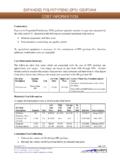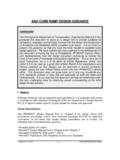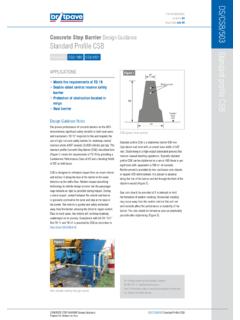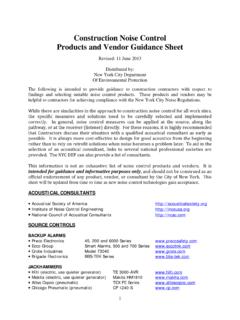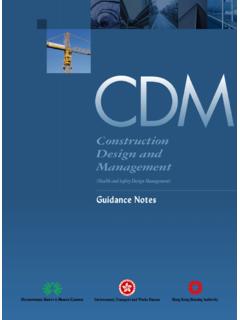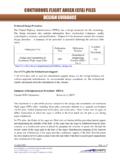Transcription of LIGHTWEIGHT FILL DESIGN GUIDANCE - GeoTech …
1 LIGHTWEIGHT fill November 2012 Page 1 of 11 G02 GEOTECHNICAL SOLUTIONS FOR SOIL IMPROVEMENT, RAPID EMBANKMENT CONSTRUCTION, AND STABILIZATION OF PAVEMENT WORKING PLATFORM DESIGN GUIDANCE Preferred DESIGN Procedure The Federal Highway Administration (FHWA) and National Cooperative Highway Research Program (NCHRP) have two documents for this technology that contain DESIGN GUIDANCE information. They are: Publication Title Publication Year Publication Number Available for Download Ground Improvement Methods - Volume I (Elias et al. 2006) 2006 FHWA NHI-06-019 No1 Geofoam Applications in the DESIGN and Construction of Highway Embankments (Stark et al. 2004b) 2004 NCHRP Web Document 65 Yes2 1 2 Summary of DESIGN /Analysis Procedure: General DESIGN GUIDANCE Current FHWA Reference(s): Supporting Reference(s): Elias et al. (2006) Christopher et al.
2 (2006) NYSDOT (2008) LIGHTWEIGHT fills have been used in the geotechnical DESIGN of highway embankments to reduce the possibility of ultimate and serviceability failures. Ultimate failures are generally described as the total collapse of the embankment. This failure mode is associated with the strength of the materials in the foundation and embankment, and it can result from bearing capacity failure of the soil beneath the embankment or slope stability failure through the embankment and the foundation. The use of LIGHTWEIGHT fills rather than standard fill material can reduce the load on the underlying soils, thus increasing the factor of safety against ultimate failure. Serviceability failures can generally be described as settlement or movements of the surface, , excessive total settlements, rutting, or differential settlements that would deem the embankment unusable.
3 Serviceability failures are generally associated with compression of the foundation or embankment materials. Because LIGHTWEIGHT fills reduce the load on the foundation soils, they reduce settlements. For DESIGN and construction purposes, LIGHTWEIGHT fills can generally be grouped into two categories: materials that behave and have properties similar to granular soils, and materials that LIGHTWEIGHT fill November 2012 Page 2 of 11 G02 GEOTECHNICAL SOLUTIONS FOR SOIL IMPROVEMENT, RAPID EMBANKMENT CONSTRUCTION, AND STABILIZATION OF PAVEMENT WORKING PLATFORM DESIGN GUIDANCE have an unconfined compressive strength and behave similarly to cohesive soils in undrained loading (Elias et al. 2006). Granular LIGHTWEIGHT fill materials include: Wood fiber. Blast furnace slag. Boiler slag. Fly ash. Expanded Shale, Clay & Slate (ESCS).
4 Shredded tires. LIGHTWEIGHT fill materials with an unconfined compressive strength include: Geofoam. Cellular concrete. The same DESIGN procedures used for conventional fills can be used for granular LIGHTWEIGHT fill materials with additional considerations dependent on the specific LIGHTWEIGHT material. These additional considerations may include evaluation of the durability, water absorption potential, corrosion potential, combustion potential, erosion potential, and environmental impacts. Elias et al. (2006) provides a list of environmental, DESIGN , and construction considerations for each of the specific granular LIGHTWEIGHT fill materials, as well as summaries of their DESIGN parameters. For tire shred embankments, NYSDOT (2008) provides a useful summary of DESIGN guidelines that address post-construction compression, separation of tire shreds from surrounding soil, and fill geometry to prevent spontaneous combustion.
5 DESIGN procedures for LIGHTWEIGHT fill materials with unconfined compressive strength are unique to the specific material. For Expanded PolyStyrene (EPS) geofoam, the DESIGN procedure is divided into three main categories: pavement DESIGN , internal stability, and external stability. Each of these is discussed in detail in the NCHRP Geofoam DESIGN Procedure summary below. Elias et al. (2006) provides a table of average properties for geofoam and cellular concrete as well as a list of specific DESIGN and construction considerations. The pavement DESIGN procedure for all LIGHTWEIGHT fill types is best summarized by the following excerpt from FHWA NHI-05-037: Geotechnical Aspects of Pavements (Christopher et al. 2006): With regard to pavement DESIGN , if a minimum of 1 m (3 ft) of good quality gravel type fill is placed between the pavement structure and the LIGHTWEIGHT materials as a cover, then the LIGHTWEIGHT material will have little impact on pavement DESIGN , even for the more compressible tire and geofoam materials.
6 LIGHTWEIGHT fill November 2012 Page 3 of 11 G02 GEOTECHNICAL SOLUTIONS FOR SOIL IMPROVEMENT, RAPID EMBANKMENT CONSTRUCTION, AND STABILIZATION OF PAVEMENT WORKING PLATFORM DESIGN GUIDANCEH owever, if a thinner cover must be used, the support value for these materials must be determined. Lab tests can be used, as discussed in Chapter 5, especially for the granular type materials. The ideal method is to perform field resilient modulus tests on placed material ( , on cover soils after placement over the LIGHTWEIGHT material(s)), especially for the bulkier materials, such as tires and geofoam. Summary of DESIGN /Analysis Procedure: NCHRP Geofoam DESIGN Procedure Current NCHRP Reference(s): Supporting Reference(s): Stark et al. (2004a, b) Zornberg et al. (2005) The Transportation Research Board (TRB) National Cooperative Highway Research Program (NCHRP) completed research on NCHRP Project 24-11: Guidelines for Geofoam Applications in Embankment Projects in 2004.
7 Findings were published as NCHRP Report 529, Guideline and Recommended Standard for Geofoam Applications in Highway Embankments, and released online as NCHRP Web Document 65, Geofoam Applications in the DESIGN and Construction of Highway Embankments (Stark et al. 2004a and Stark et al. 2004b). Report 529 consists of only the recommended DESIGN guidelines and standards. Web Document 65 consists of the entire report and appendices (including the guidelines and standards from Report 529 as Appendices B & C). Henceforth, the complete report from NCHRP Project 24-11, Web Document 65, will be referred to as NCHRP 24-11. The NCHRP 24-11 report provides a step-by-step procedure for designing highway embankments using geofoam, which is another name for EPS blocks. The charts provided throughout the document are developed specifically for EPS blocks and cannot be applied to other types of LIGHTWEIGHT fills.
8 However, the general DESIGN issues and approaches are very similar for some other categories of LIGHTWEIGHT fills, , tire bales (Zornberg et al. 2005). The following paragraphs provide a descriptive summary of the DESIGN procedure in the NCHRP 24-11 report. There are three main categories of DESIGN : pavement DESIGN , external stability, and internal stability. The pavement DESIGN criteria are intended to prevent rutting, cracking, or similar pavement issues. External stability refers to how the fill mass and pavement affect the soil below. Internal stability refers to the ability of the fill mass to support itself and the pavement. Specific failure modes classified within each of these categories are discussed in subsequent paragraphs. Altering the DESIGN of the embankment to increase the factor of safety in one aspect of DESIGN can often decrease the factor of safety in another aspect.
9 For example, the use of a denser geofoam will be beneficial to the internal stability against translation, but will decrease LIGHTWEIGHT fill November 2012 Page 4 of 11 G02 GEOTECHNICAL SOLUTIONS FOR SOIL IMPROVEMENT, RAPID EMBANKMENT CONSTRUCTION, AND STABILIZATION OF PAVEMENT WORKING PLATFORM DESIGN GUIDANCEthe external stability against bearing capacity as a result of increased load. Consequently, DESIGN of LIGHTWEIGHT fill embankments is an iterative process. The DESIGN of pavement above LIGHTWEIGHT fill is similar to standard pavement DESIGN procedures once equivalent properties have been assigned to the fill . Research has been conducted on the resilient modulus of different grades of geofoam, and the results are presented in the NCHRP 24-11 document. The intent of the pavement DESIGN procedure is to provide the most economical thickness and arrangement of pavement materials while providing sufficient factors of safety against cracking and rutting.
10 It should be noted that a minimum pavement system thickness of 24 inches above the geofoam is recommended to minimize the potential for differential icing and solar heating. The pavement can be designed as an asphalt pavement, a concrete pavement, or a combination of the two. A concrete pavement system itself is generally more expensive than asphalt, but concrete more effectively dissipates the traffic loads applied to the geofoam fill , and it can allow for the use of a lighter geofoam, thus reducing costs. For flexible pavement DESIGN , a comprehensive DESIGN procedure is provided in the NCHRP 24-11 document. A DESIGN catalog for low volume roads1 is included that can be used to obtain the structural number based on the EPS type, reliability level, and traffic level. After obtaining the structural number, the AASHTO Guide for DESIGN of Pavement Structures or state DOT DESIGN manuals can be used to select layer coefficients and determine the most economical pavement system.
